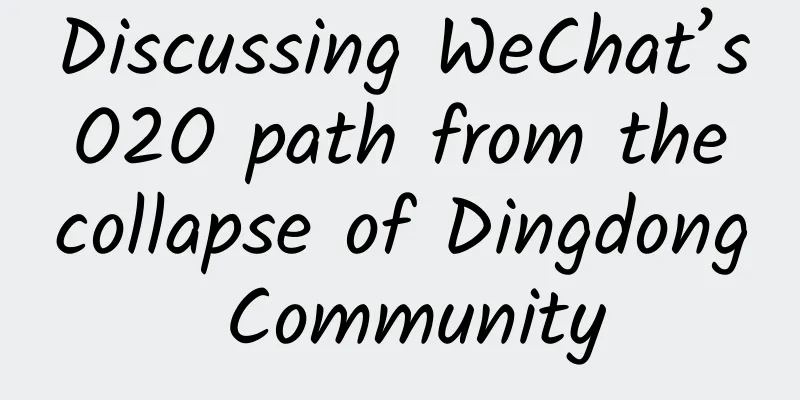Discussing WeChat’s O2O path from the collapse of Dingdong Community

|
This article Heart of Rock puts forward several controversial viewpoints that have never been proposed by others: 1. The success of O2O lies in mobile scenarios and efficiency; 2. Strong social relationships are not conducive to O2O and e-commerce; 3. A super platform is not necessarily a super portal; Recently, the news of the closure of community O2O startup Dingdong Community has undoubtedly poured cold water on the O2O market. Looking around the entire industry, I found that there are almost no decent O2O products, and it seems that they have entered the wrong development path. And the model of expanding O2O from social networking may have been wrong from the starting point. Some people say that WeChat hopes to enter O2O and e-commerce from social networking, so there should be no problem with this idea. Tencent is a company I admire very much and is also my old friend, but the road to O2O is a journey of trial and error, so I still want to express my views and opinions. Which products of WeChat are successful? Why are they successful? WeChat's current successful products include Moments, games, Didi Taxi, and connections to some smart devices. Moments have very strong stickiness because they are all friends who know each other and share articles, life, and news, so the interaction effect is very good, which is also a good reflection of WeChat's powerful social attributes. The second is games. Tencent's second quarter financial report for 2014 shows that the revenue from mobile games has reached 3 billion yuan. This data also fully proves that games can achieve very good output by relying on the social relationships and huge traffic of mobile QQ and WeChat. This is similar to QQ on the PC, and is also the result of the strong social relationship advantage. The third one is Didi Dache, a taxi-hailing product invested by Tencent. It has now surpassed the development speed of Kuaidi Taxi. It is the only product of WeChat that has achieved success in connecting services, mainly because of the extremely high efficiency of connecting services, as well as the stickiness of social relationships and the number of users. For a new and occasionally used service, users do not need to register an account separately. The fourth is the customer service platform, which is also a very good use of WeChat. The distance between users and enterprises is greatly shortened, making it an efficient customer relationship management tool. This is also the social and communication advantages of WeChat. In addition, some smart devices developed by WeChat, such as the smart air conditioner in cooperation with Haier, is also a good direction. As an almost universal application, it can become the most convenient tool to replace the remote control, which also reflects the huge advantages of WeChat's user base and interface. Judging from the above successful cases, what WeChat can do well is closely related to its essential social attributes. At the same time, open interfaces and user volume also play an important role. Why is WeChat’s e-commerce not doing well? WeChat has many products that are not doing well, including the WeChat e-commerce that is being promoted now, and the channels opened for JD.com and Dianping to connect services. According to the feedback from JD.com and Dianping, although WeChat has abundant traffic, it is not very effective in directing traffic to e-commerce and services. What is the reason for this? I think there are two main reasons. First, the lack of scenario-based design; second, the lack of efficiency. I once talked about a point of view: in the future, people will not live in containers bound by Internet IDs, but in ever-changing mobile scenarios. This view has been supported. On the one hand, ubiquitous networks and connected devices have become the basic conditions for building mobile scenarios. On the other hand, the scenarios for connecting people and services are not fixed, but are constantly changing. For example, I am in Qingdao today, and I will be on a business trip to Beijing tomorrow. I am in the office now, and I will be in the car, at home, and in the hotel in a while. There are connectable platforms in these ever-changing scenarios. WeChat cannot meet more usage scenarios. For example, when I am on a business trip, the products I use most may be maps or search. If I want to find a hotel or restaurant, I must first know my location and then look for surrounding services. This is more efficient. On WeChat, I need to open only Dianping to find services, which is obviously inefficient. I have always believed that when connecting services, efficiency must be prioritized, not social interaction. Previously, a foreigner invented the term SOLOMO (social location mobility), which well defines the three basic conditions of O2O. However, we found that only in a certain mobile scenario do we think of the need for connecting services. At the same time, social interaction is the least efficient activity, and to enjoy services and transactions, high efficiency is required. For example, when I go to a hotel for dinner, I don’t need to communicate much with the hotel customer service first. It is better to make a judgment based on more user reviews and then pay directly. Communication means low efficiency. The greatest value of WeChat lies in communication and strong social relationships. On the contrary, connecting services and transactions does not require strong social relationships. Weak social relationships have higher transaction efficiency. However, WeChat did not consider the efficiency issue from the user's perspective. They only considered it from the merchant's perspective, helping merchants retain users, which is the so-called corporate service account. Obviously, there is nothing wrong with WeChat's consideration, because the essential attribute of WeChat is social, so it hopes to exert its value to enable better communication between enterprises and users, but few users are willing to communicate more with merchants. At this point, many people may understand why the community O2O startup project Dingdong Community failed, because they put social networking first, which led to insufficient user usage scenarios and low efficiency, so there was almost no hope of success. A friend who did a community O2O project similar to Dingdong told me that he used money and time to prove that the idea of community O2O to do social networking first was wrong. Many entrepreneurs believe that strengthening social relationships first and stickiness first and then doing O2O services is a creed, and my point of view is to reverse this perception: O2O's requirements for mobile scenarios and efficiency far exceed the stickiness of social relationships, and weak social relationships are more advantageous for O2O. Why is it so difficult for e-commerce to obtain considerable traffic from WeChat? I think e-commerce is not a scenario-based consumption, but a targeted consumption. At present, in the e-commerce market, Alibaba's Taobao and Tmall, as well as JD.com, already have very strong brand influence and user volume, and have built a complete user experience and shopping rules. Users do not need to complete shopping in WeChat. In addition, research shows that the effect of selling goods to acquaintances is very poor. Transactions between acquaintances are affected by various emotions and transaction risk psychology, and it is almost impossible to achieve large-scale and sustainable sales. Some people may ask, why do Taobao, Tmall and JD.com all place ads in advertising alliances to gain traffic? In fact, the ads placed by advertising alliances are generally matched with the content of the webpage, user search habits, etc., and are a kind of precise advertising. For example, if you have searched for a certain mobile phone, Baidu's ads may display some mobile phone ads of e-commerce platforms on the page. This can obtain precise traffic for e-commerce, and is also a kind of scenario-based traffic diversion, which WeChat cannot achieve. To sum up, the main problems faced by WeChat in connecting services and e-commerce are the lack of mobile scenario trends, low transaction efficiency under strong social conditions, and the centralization of e-commerce brands and the influence of consumer psychology. What should WeChat connection service do best? In addition to social networking, communication, and games, what else can WeChat do? I think WeChat should fully tap into its own communication capabilities, social capabilities, and user value. Judging from the current APP download reports, users have evolved from blindly installing some apps to precise installation, that is, they will install a specific APP for a certain need of their own. APPs have been eliminated by the waves, and the remaining ones are the strongest in a certain field. Therefore, users will download APPs according to their own usage scenarios, and then start using them in a certain scenario. This means that the Internet access in the mobile Internet era will be completely fragmented, and the O2O entrance will also become very fragmented. Maps, search, social networking, phone calls, menstruation, driving, going to the toilet, eating, sleeping, and any other different scenarios may become an O2O entrance, and there may be matching APPs to provide services in these entrances, because for occasional services, opening an APP is the most efficient. In addition, the current cost of registering an ID is very low, a mobile phone number plus a receipt SMS is enough, and it can even be tied to social relationships on public platforms such as QQ and Weibo, so any ID with strong social relationships cannot monopolize the O2O entrance in the fragmented mobile scenario. This means that WeChat must open its thinking and vision, instead of hoping to build itself into a super platform. The main way to become a super portal is not to concentrate, but to disperse. This is a reverse way of thinking in today's mobile Internet era and also a kind of business wisdom. However, WeChat's social and communication capabilities are unmatched, and it can fully release this capability to its partners. Tencent seems to be doing similar work, for example, investing in registration platforms. WeChat can become a tool for communication between patients and doctors, and can be used for remote medical consultations. Doctors and patients need complex communication, which is a capability that WeChat, with its strong social relationships, possesses. Tencent should continue to increase investments and layouts based on strong social relationships. In addition, WeChat's communication and social capabilities can be used to provide services for other connection service applications and platforms, allowing WeChat to be distributed at the bottom of more connection service apps, responsible for communication between enterprises and users, and helping enterprises manage customer relationships. I think this is the greatest value and future of WeChat's connection services. More decentralized practices are yet to be thought about and developed by WeChat itself. I just hope that Tencent can give up the idea of becoming a super platform first, because only when the thinking is no longer rigid and bound can it become a real super portal, a portal that is everywhere. Finally, I also wish WeChat a brighter future and better realize Tencent's dream of connecting everything. As a winner of Toutiao's Qingyun Plan and Baijiahao's Bai+ Plan, the 2019 Baidu Digital Author of the Year, the Baijiahao's Most Popular Author in the Technology Field, the 2019 Sogou Technology and Culture Author, and the 2021 Baijiahao Quarterly Influential Creator, he has won many awards, including the 2013 Sohu Best Industry Media Person, the 2015 China New Media Entrepreneurship Competition Beijing Third Place, the 2015 Guangmang Experience Award, the 2015 China New Media Entrepreneurship Competition Finals Third Place, and the 2018 Baidu Dynamic Annual Powerful Celebrity. |
<<: Why did Xunlei’s market value shrink by nearly 2.2 billion after its listing?
>>: Ali Baichuan is here: Who might have a headache?
Recommend
Watching a suspense drama actually made me ravenous! There are so many delicacies in "The Long Season"...
During the recent May Day holiday, the shoes of &...
New research: Feeling stressed? It's because there's something wrong with the brain's reward mechanism!
In life, we often face various pressures. Some pe...
The latest "mask order" has been issued! National Center for Disease Control and Prevention: Masks are still required in these scenarios
Guidelines for the public to wear masks to preven...
The cold wind is howling. Each plant has its own unique way to save its life!
In order to compete for limited sunlight and wate...
Bright blue iPhone 7 stunning unboxing in China: third-party customized luxury packaging
Apple has spent a lot of effort on the iPhone 7, n...
One article to solve private domain traffic
This article is divided into two parts: The theor...
Soul advertising, Soul account recharge, Soul promotion background
The Soul platform has prospered to the point wher...
The past and present of trenches - why should deep-sea research focus on trenches?
Editor’s Note: On November 25, 2022, the "St...
Can hot water disinfect and sterilize bowls? Don't underestimate bacteria, try these methods to kill them →
Author: Xu Dong, Associate Professor, School of F...
Nvidia: AI computing is accelerating
NVIDIA held its 2018 fiscal year investor confere...
Recommended books for beginners of web front-end development, 105 excellent e-books on front-end development (Baidu Netdisk)
With the advent of the 5G era, the Internet has b...
Would you like to exchange your Android phone for an Apple phone?
One sentence review: Apple, you are going to heav...
Li Guyi's resume: How to do website traffic analysis?
Website traffic analysis refers to the statistics...
What is the price for Weifang Lighting Mini Program investment? Weifang lamps mini program investment price inquiry
How much is the investment price for Weifang Ligh...
Ten ways to reverse your financial thinking
There is a fine line between going against the cu...









